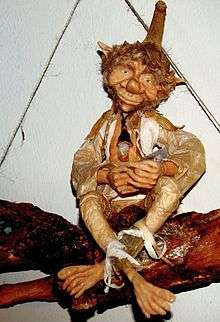Duende
A duende is a creature somewhat like a human from Iberian, Latin American, and Filipino folklore. The Spanish term duende originated as a contraction of the phrase dueño de casa or duen de casa, "possessor of a house", and was originally conceptualized as a mischievous spirit inhabiting a house.[1]
.jpg)
Usage

Portuguese
The word is also used in Portuguese folklore, being used to describe beings of a small stature wearing big hats, whistling a mystical song, while walking in the forest (and rendered in English by "goblins", "pixies", "brownies", “elves”, and "leprechauns"). Using their talent, they are believed to lure young girls and boys to the forest causing them to lose their way home.
Latin America
Conversely, in some Latin American cultures, duendes are believed to be the helpers of people who get lost in the forest so they could find their way home. In the folklore of the Central American country of Belize, particularly amongst the country's African/Island Carib-descended Creole and Garifuna populations, duendes are thought of as forest spirits called "Tata Duende" who lack thumbs.[2] . The Yucatec Maya of Belize have duendes such as Alux and Nukux Tat which are seen as Guardian spirits of the forest .
In the Hispanic folklore of Mexico and the American Southwest, duendes are known as gnome-like creatures who live inside the walls of homes, especially in the bedroom walls of young children. They attempt to clip the toenails of unkempt children, often leading to the mistaken removal of entire toes.[3] Belief in duendes still exists among the Mixtecs and Zapotecs of Oaxaca and it is said that they are most commonly found in the mossy cloud forests of the state's mountain ranges.
Philippines and Mariana Islands
Some Filipinos believe in dwende, which often dwell in rocks and caves, old trees, unvisited and dark parts of houses, or in anthills and termite mounds. Those that live in the last two are termed nunò sa punsó (Tagalog for “old man of the mound”). They are either categorized as good or evil depending on their color (white or black, respectively), and are often said to play with children (who are more capable than adults of seeing them). Offending a nunò sa punsó is taboo; people who step on them are believed to be cursed by the angered dwende within.
The Chamorro people of the Marianas Islands tell tales of the taotaomo'na, duendes and other spirits. A duende, according to the Chamorro-English Dictionary by Donald Topping, Pedro Ogo and Bernadita Dungca, is a goblin, elf, ghost or spook in the form of a dwarf, a mischievous spirit which hides or takes small children.
Notes
- Joan Corominas, 'Breve diccionario etimológico de la lengua castellana', "Duende" (Madrid: Editorial Gredos, 1980).
- Emmons (1997).
- See retelling in Garza (2004, pp. 2–11).
References
- Emmons, Katherine M. (October 1997). "Perceptions of the Environment while Exploring the Outdoors: a case study in Belize". Environmental Education Research. Ambingdon, Oxfordshire: Carfax Publishing, in conjunction with the University of Bath. 3 (3): 327–344. doi:10.1080/1350462970030306. OCLC 34999650.
- Garza, Xavier (2004). Creepy Creatures and other Cucuys (Piñata Books imprint ed.). Houston, TX: Arte Público Press. ISBN 1-55885-410-X. OCLC 54537415.